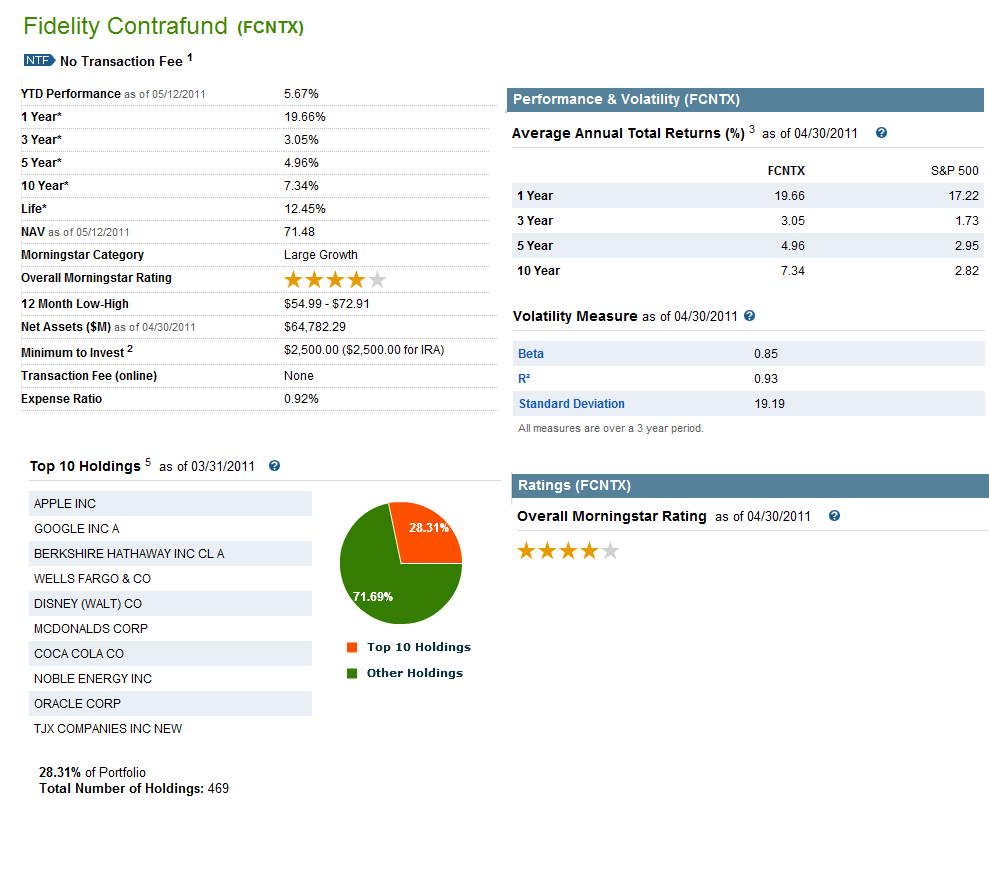Understanding Fidelity Contrafund: A Comprehensive Guide To Its Performance And Benefits
Fidelity Contrafund has long been a popular choice among investors seeking growth in their portfolios. This mutual fund, managed by Fidelity Investments, is designed to provide exposure to large-cap growth stocks with the potential for significant capital appreciation. As a cornerstone in many investment strategies, it’s crucial to understand its features, performance metrics, and how it fits into your overall investment goals.
In this article, we will delve deep into the Fidelity Contrafund, exploring its history, investment strategy, performance over the years, and how it compares to other funds in the market. Additionally, we will discuss the benefits and potential risks associated with investing in this fund, providing you with a well-rounded perspective.
Whether you are a seasoned investor or a newcomer to the financial world, understanding Fidelity Contrafund can enhance your investment strategy. Let’s embark on this journey to uncover the intricacies of this renowned mutual fund.
Table of Contents
- 1. History of Fidelity Contrafund
- 2. Investment Strategy
- 3. Performance Overview
- 4. Comparison with Other Funds
- 5. Benefits of Investing in Fidelity Contrafund
- 6. Risks Associated with Fidelity Contrafund
- 7. Key Data and Statistics
- 8. Conclusion
1. History of Fidelity Contrafund
Fidelity Contrafund was established in 1967 and has since become one of the largest and most recognized mutual funds in the United States. It was founded by famed portfolio manager Will Danoff, who has managed the fund since its inception. Under Danoff’s stewardship, the fund has consistently aimed to invest in companies that are undervalued relative to their long-term growth potential.
The fund’s philosophy is rooted in the belief that the stock market often misprices growth potential, leading to opportunities for savvy investors. Over the decades, Fidelity Contrafund has adapted to market changes while maintaining its core investment principles.
2. Investment Strategy
The investment strategy of Fidelity Contrafund is primarily focused on growth stocks. The fund seeks to identify companies that are expected to grow faster than the market average. Here are some key aspects of its investment strategy:
- Bottom-Up Research: The fund relies on extensive research to evaluate individual companies rather than focusing solely on broader market trends.
- Long-Term Perspective: Fidelity Contrafund typically holds investments for the long term, allowing growth to materialize.
- Diversification: The fund invests across various sectors and industries to mitigate risk.
2.1. Stock Selection Criteria
Fidelity Contrafund employs a rigorous stock selection process that considers several factors, including:
- Growth potential of the company
- Competitive advantages and market position
- Financial health and profitability metrics
3. Performance Overview
Over its decades-long history, Fidelity Contrafund has delivered impressive returns, often outperforming its benchmark, the S&P 500 Index. While past performance does not guarantee future results, historical data showcases the fund's resilience and growth trajectory.
As of the latest updates, the fund has an average annual return of approximately 12% over the last 10 years, demonstrating its effectiveness as a growth investment.
4. Comparison with Other Funds
When evaluating Fidelity Contrafund, it’s helpful to compare it with other popular mutual funds. Here’s how it stacks up against a few notable competitors:
- Vanguard Growth Index Fund: While both funds focus on growth, Fidelity Contrafund has a more active management approach, which can lead to higher returns but also comes with higher fees.
- T. Rowe Price Blue Chip Growth Fund: Similar in strategy, but Fidelity’s long-term track record gives it an edge in consistency and performance.
5. Benefits of Investing in Fidelity Contrafund
Investing in Fidelity Contrafund offers several benefits:
- Experienced Management: With Will Danoff at the helm, investors can trust in the expertise and judgment of a seasoned manager.
- Diversified Portfolio: The fund’s broad range of investments helps reduce risk.
- Strong Historical Performance: The impressive track record provides confidence for prospective investors.
6. Risks Associated with Fidelity Contrafund
While there are many benefits to investing in Fidelity Contrafund, it’s essential to be aware of the risks as well:
- Market Risk: Like all equity investments, the fund is subject to market fluctuations.
- Management Risk: The performance of the fund is heavily dependent on the decisions made by its manager.
- Fees: As an actively managed fund, Fidelity Contrafund typically has higher fees compared to passive index funds.
7. Key Data and Statistics
Here’s a quick overview of key data related to Fidelity Contrafund:
| Feature | Details |
|---|---|
| Fund Inception | 1967 |
| Manager | Will Danoff |
| Average Annual Return (10 Years) | 12% |
| Expense Ratio | 0.82% |
8. Conclusion
Fidelity Contrafund remains a compelling option for investors seeking growth through a well-managed mutual fund. Its long history of performance, combined with an experienced management team, makes it a worthy consideration for those looking to build a robust investment portfolio.
As you consider your investment options, think about how Fidelity Contrafund fits within your overall strategy. For further insights or to share your thoughts, feel free to leave a comment below or explore other articles on our site.
Thank you for reading, and we hope to see you back on our site for more financial insights!
Exploring The Jordan 6 Aqua: A Timeless Sneaker Icon
Costco Visa Login: A Comprehensive Guide To Accessing Your Account
Cowboys Game Channel: Your Ultimate Guide To Watching America's Team



